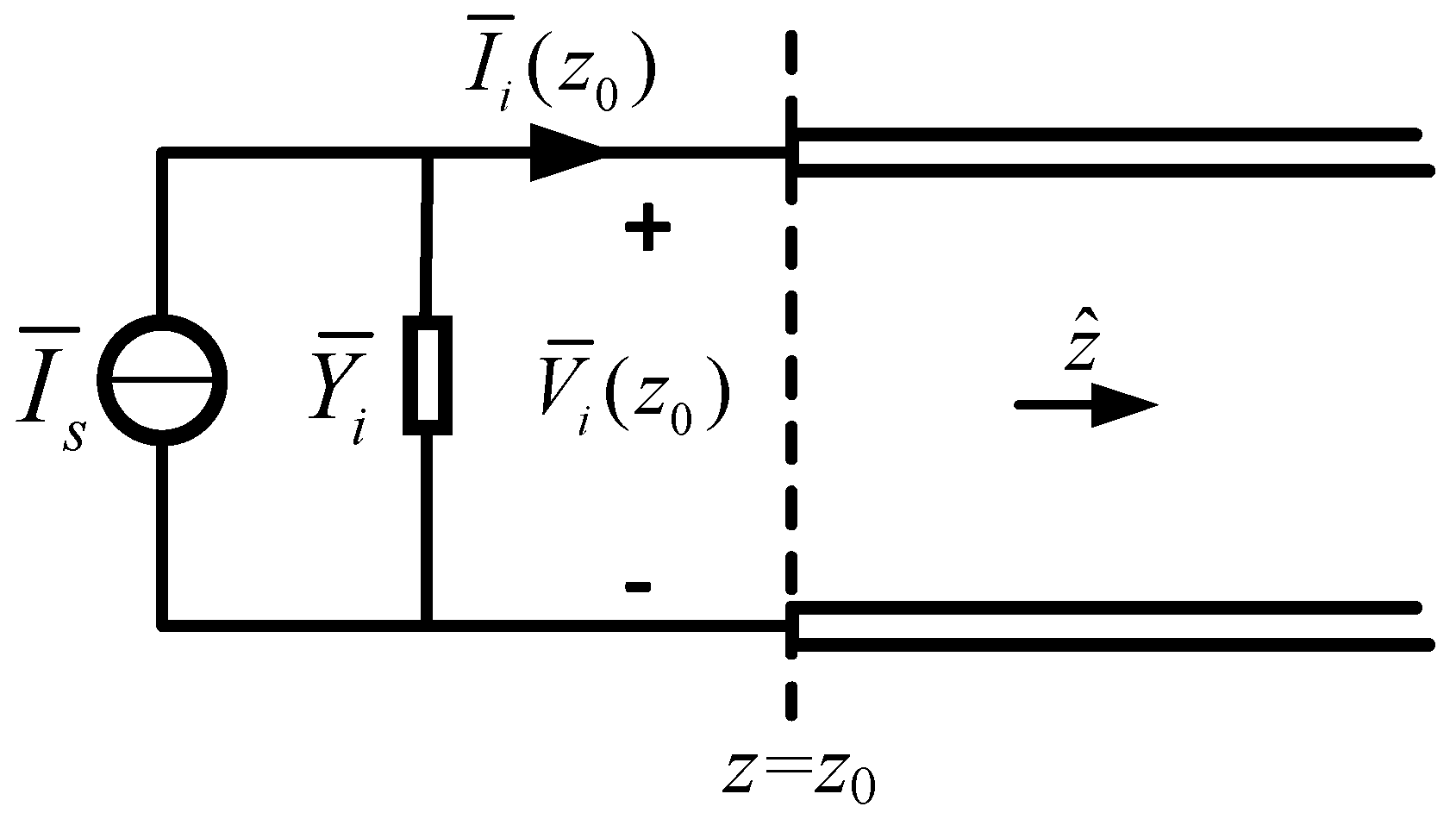A Circuit-Based Wave Port Boundary Condition for the Nodal Discontinuous Galerkin Time-Domain Method
Abstract
:1. Introduction
2. The DGTD Method
3. The Modal Circuit-Based WPBC
4. Co-Simulation of Modal Circuit and WLTL
4.1. Field-Circuit Co-Simulation
4.2. S-Parameters and Port Power
5. Results and Discussion
5.1. Performance Validation
5.2. Waveguide Filter
5.3. Circular Horn Antenna
5.4. Electromagnetic Bandgap (EBG) Structure
6. Conclusions
Author Contributions
Funding
Data Availability Statement
Conflicts of Interest
References
- Hesthaven, J.S.; Warburton, T. Nodal Discontinuous Galerkin Methods: Algorithms, Analysis, and Applications; Springer: New York, NY, USA, 2008. [Google Scholar]
- Angulo, L.D.; Alvarez, J.; Pantoja, M.F.; Garcia, S.G.; Bretones, A.R. Discontinuous Galerkin time domain methods in computational electrodynamics: State of the art. Forum Electromagn. Res. Methods Appl. Technol. 2015, 10, 1–24. [Google Scholar]
- Li, X.L.; Jin, J.M. A comparative study of three finite element-based explicit numerical schemes for solving Maxwell’s equations. IEEE Trans. Antennas Propag. 2012, 60, 1450–1457. [Google Scholar] [CrossRef]
- Chen, J.F.; Liu, Q.H. Discontinuous Galerkin time-domain methods for multiscale electromagnetic simulations: A review. Proc. IEEE 2013, 101, 242–254. [Google Scholar] [CrossRef]
- Dosopoulos, S.; Lee, J.F. Interior penalty discontinuous Galerkin finite element method for the time-dependent first order Maxwell’s equations. IEEE Trans. Antennas Propag. 2010, 58, 4085–4090. [Google Scholar] [CrossRef]
- Tian, C.Y.; Shi, Y.; Shum, K.M.; Chan, C.H. Wave equation-based discontinuous Galerkin time domain method for co-simulation of electromagnetics-circuit systems. IEEE Trans. Antennas Propag. 2020, 68, 3026–3036. [Google Scholar] [CrossRef]
- Wang, P.; Shi, Y.; Tian, C.Y.; Li, L. Analysis of Graphene-based devices using wave equation-based discontinuous Galerkin time domain method. IEEE Antennas Wirel. Propag. Lett. 2018, 17, 2169–2173. [Google Scholar] [CrossRef]
- Tian, C.Y.; Shi, Y.; Chan, C.H. An improved vector wave equation-based discontinuous Galerkin time domain method and its hybridization with Maxwell’s equation-based discontinuous Galerkin time domain method. IEEE Trans. Antennas Propag. 2018, 66, 6170–6178. [Google Scholar] [CrossRef]
- Shi, Y.; Tian, C.Y.; Liang, C.H. Discontinuous Galerkin time-domain method based on marching-on-in-degree scheme. IEEE Antennas Wirel. Propag. Lett. 2017, 16, 250–253. [Google Scholar] [CrossRef]
- Ban, Z.G.; Shi, Y.; Yang, Q.; Wang, P.; Zhu, S.C.; Li, L. GPU-accelerated hybrid discontinuous Galerkin time domain algorithm with universal matrices and local time stepping method. IEEE Trans. Antennas Propag. 2020, 68, 4738–4752. [Google Scholar] [CrossRef]
- Ban, Z.G.; Shi, Y.; Wang, P. Advanced parallelism of DGTD method with local time stepping based on novel MPI + MPI unified parallel algorithm. IEEE Trans. Antennas Propag. 2022, 70, 3916–3921. [Google Scholar] [CrossRef]
- Li, P.; Jiang, L.J.; Bagci, H. Transient analysis of dispersive power-ground plate pairs with arbitrarily shaped antipads by the DGTD method with wave port excitation. IEEE Trans. Electromag. Compat. 2017, 59, 172–183. [Google Scholar] [CrossRef]
- Bansal, M.; Singh, H.; Sharma, G. A taxonomical review of multiplexer designs for electronic circuits & devices. J. Electron. Inform. 2021, 3, 77–88. [Google Scholar]
- Berenger, J.P. A perfectly matched layer for the absorption of electromagnetic waves. J. Comput. Phys. 1994, 114, 185–200. [Google Scholar] [CrossRef]
- Wolter, H.; Dohlus, M.; Weiland, T. Broadband calculation of scattering parameters in the time domain. IEEE Trans. Magn. 1994, 30, 3164–3167. [Google Scholar] [CrossRef]
- Geib, B.; Dohlus, M.; Weiland, T. Calculation of scattering parameters by orthogonal expansion and finite integration method. Int. J. Numer. Model. 1994, 7, 377–398. [Google Scholar] [CrossRef]
- Alimenti, F.; Mezzanotte, P.; Roselli, L.; Sorrentino, R. Modal absorption in the FDTD method: A critical review. Int. J. Numer. Model. 1997, 10, 245–264. [Google Scholar] [CrossRef]
- Chen, G.; Stang, J.; Moghaddam, M. A conformal FDTD method with accurate waveport excitation and S-parameter extraction. IEEE Trans. Antennas Propag. 2016, 64, 4504–4509. [Google Scholar] [CrossRef]
- Potratz, C.; Glock, H.; Rienenk, U.V. Time-domain field and scattering parameter computation in waveguide structures by GPU-accelerated discontinuous-Galerkin method. IEEE Trans. Microw. Theory Technol. 2011, 59, 2788–2797. [Google Scholar] [CrossRef]
- Lou, Z.; Jin, J.M. An accurate waveguide port boundary condition for the time-domain finite-element method. IEEE Trans. Microw. Theory Technol. 2005, 53, 3014–3023. [Google Scholar]
- Wang, R.; Jin, J.M. A symmetric electromagnetic-circuit simulator based on the extended time-domain finite element method. IEEE Trans. Microw. Theory Technol. 2008, 56, 2875–2884. [Google Scholar] [CrossRef]
- Loh, T.H.; Mias, C. Implementation of an exact modal absorbing boundary termination condition for the application of the finite-element time-domain technique to discontinuity problems in closed homogeneous waveguides. IEEE Trans. Microw. Theory Technol. 2004, 52, 882–888. [Google Scholar] [CrossRef]
- Zhao, L.; Chen, G.; Yu, W.; Jin, J.M. A fast waveguide port parameter extraction technique for the DGTD method. IEEE Antennas Wirel. Propag. Lett. 2017, 16, 2659–2662. [Google Scholar] [CrossRef]
- Chang, C.P.; Chen, G.; Yan, S.; Jin, J.M. Waveport modeling for the DGTD simulation of electromagnetic devices. Int. J. Numer. Model. 2018, 31, e2226. [Google Scholar] [CrossRef]
- Marcuvitz, N. Waveguide Handbook; IET: London, UK, 1986. [Google Scholar]
- Li, L.; Chen, Q.; Yuan, Q.; Sawaya, K. Ultrawideband suppression of ground bounce noise in multilayer PCB using locally embedded planar electromagnetic band-gap structures. IEEE Antennas Wirel. Propag. Lett. 2009, 8, 740–743. [Google Scholar]







| PML | WPBC | CWPBC | |
|---|---|---|---|
| CPU time Time Ratio | 134.76 s 1 | 10.51 s 0.078 | 9.84 s 0.073 |
Publisher’s Note: MDPI stays neutral with regard to jurisdictional claims in published maps and institutional affiliations. |
© 2022 by the authors. Licensee MDPI, Basel, Switzerland. This article is an open access article distributed under the terms and conditions of the Creative Commons Attribution (CC BY) license (https://creativecommons.org/licenses/by/4.0/).
Share and Cite
Zhu, S.; Shi, Y.; Ban, Z. A Circuit-Based Wave Port Boundary Condition for the Nodal Discontinuous Galerkin Time-Domain Method. Electronics 2022, 11, 1842. https://doi.org/10.3390/electronics11121842
Zhu S, Shi Y, Ban Z. A Circuit-Based Wave Port Boundary Condition for the Nodal Discontinuous Galerkin Time-Domain Method. Electronics. 2022; 11(12):1842. https://doi.org/10.3390/electronics11121842
Chicago/Turabian StyleZhu, Shichen, Yan Shi, and Zhenguo Ban. 2022. "A Circuit-Based Wave Port Boundary Condition for the Nodal Discontinuous Galerkin Time-Domain Method" Electronics 11, no. 12: 1842. https://doi.org/10.3390/electronics11121842





